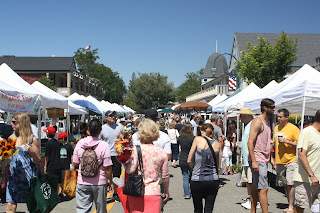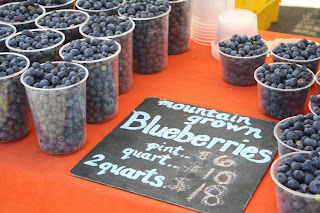This morning, my family and I went to our town's downtown farmers' market to enjoy the company of our community, enjoy the fresh air and fresh produce, and to get a knife sharpened at one of the booths. I also was able to snap some photos for the green tips guide I'm editing for the City.
After we dropped off the knife to be sharpened at one end of the market, we wandered back down to Main Street and explored an art gallery, which sells locally crafted art, paintings, and jewelry. I observed that the jewelry prices were all at least $40, which seemed high to me. Then I realized that in order for a local artist to make a living selling jewelry and in order to use fine quality materials, that is the true cost. I'm so used to prices you might see at big chain stores where the jewelry is made in China out of cheap materials. Though I stopped buying lots of jewelry awhile back, realizing this made me want to be selective and thoughtful the next time I do want to get some jewelry. Most of the different jewelry displays had information about the artist, so I could easily find out more about the jewelry, where the products come from (how far the raw materials have to travel to the artist), and how local the artist really is. As I think about it now, I'm realizing that the best kinds of local jewelry would contain locally sourced materials, like leathers and fibers, and use recycled metals that ended up in this area from some other use and were repurposed into jewelry.
Buying local, high quality products is a huge part of sustainability not only because it requires fewer miles to travel to me, thus reducing carbon dioxide emissions, but it also stimulates the local economy and the products last longer and don't need to be replaced all the time. Having a strong local economy helps sustain the community and city programs and city projects that allow for a higher quality of living. All of this helps to sustain a thriving community and life for those who live here.
Speaking of buying locally, here is a fabulous entry by One Green Generation about what it means to Live Locally. Her ten steps are Going slow, Being neighborly, Working locally, Volunteering locally, Supporting local businesses, Supporting a local barter economy, Supporting local (green) infrastructure, Going to community events, Eating locally, and Finding your own way. I highly recommend checking it out--we can all find ways to live more locally and truly engage with our communities in meaningful ways.
As we wandered back into the market, we saw a stall selling gluten-free Roti Bread and Spinach Besan Pura. My mom is gluten-free and my whole family is dairy-free, so they were the perfect snack (see a photo of them below that includes an ingredients list). Plus, they have protein, so they can be considered a complete meal. The company is based in a city only 15 miles from where I live, so it certainly is local. We bought one package of each (unfortunately they come in plastic bags), said no thank you to the plastic bag the merchant offered us, packed them in a reusable bag, and continued walking through the market. I snapped some final photos, sampled some delicious peaches, and we headed home.
I heated the spinach bread in some coconut oil in a pan on the stove with sea salt and it was pretty tasty. I added some Widow Maker hot sauce to give it some extra flavor. I haven't tried the roti bread yet, but it looks like it will taste similar to the spinach bread. Anyone have any suggestions for ways to prepare the bread with other things to make it more exciting?
Here are some more photos from the market today:
Thanks for reading!
Green Gal
--
All photos in this post are property of Green Gal. If you would like to repost them on your own site, please include photo credit and a link back to this post. Thank you!
After we dropped off the knife to be sharpened at one end of the market, we wandered back down to Main Street and explored an art gallery, which sells locally crafted art, paintings, and jewelry. I observed that the jewelry prices were all at least $40, which seemed high to me. Then I realized that in order for a local artist to make a living selling jewelry and in order to use fine quality materials, that is the true cost. I'm so used to prices you might see at big chain stores where the jewelry is made in China out of cheap materials. Though I stopped buying lots of jewelry awhile back, realizing this made me want to be selective and thoughtful the next time I do want to get some jewelry. Most of the different jewelry displays had information about the artist, so I could easily find out more about the jewelry, where the products come from (how far the raw materials have to travel to the artist), and how local the artist really is. As I think about it now, I'm realizing that the best kinds of local jewelry would contain locally sourced materials, like leathers and fibers, and use recycled metals that ended up in this area from some other use and were repurposed into jewelry.
Buying local, high quality products is a huge part of sustainability not only because it requires fewer miles to travel to me, thus reducing carbon dioxide emissions, but it also stimulates the local economy and the products last longer and don't need to be replaced all the time. Having a strong local economy helps sustain the community and city programs and city projects that allow for a higher quality of living. All of this helps to sustain a thriving community and life for those who live here.
Speaking of buying locally, here is a fabulous entry by One Green Generation about what it means to Live Locally. Her ten steps are Going slow, Being neighborly, Working locally, Volunteering locally, Supporting local businesses, Supporting a local barter economy, Supporting local (green) infrastructure, Going to community events, Eating locally, and Finding your own way. I highly recommend checking it out--we can all find ways to live more locally and truly engage with our communities in meaningful ways.
As we wandered back into the market, we saw a stall selling gluten-free Roti Bread and Spinach Besan Pura. My mom is gluten-free and my whole family is dairy-free, so they were the perfect snack (see a photo of them below that includes an ingredients list). Plus, they have protein, so they can be considered a complete meal. The company is based in a city only 15 miles from where I live, so it certainly is local. We bought one package of each (unfortunately they come in plastic bags), said no thank you to the plastic bag the merchant offered us, packed them in a reusable bag, and continued walking through the market. I snapped some final photos, sampled some delicious peaches, and we headed home.
I heated the spinach bread in some coconut oil in a pan on the stove with sea salt and it was pretty tasty. I added some Widow Maker hot sauce to give it some extra flavor. I haven't tried the roti bread yet, but it looks like it will taste similar to the spinach bread. Anyone have any suggestions for ways to prepare the bread with other things to make it more exciting?
Here are some more photos from the market today:
Thanks for reading!
Green Gal
--
All photos in this post are property of Green Gal. If you would like to repost them on your own site, please include photo credit and a link back to this post. Thank you!










Comments
Post a Comment
Thank you for your comment!